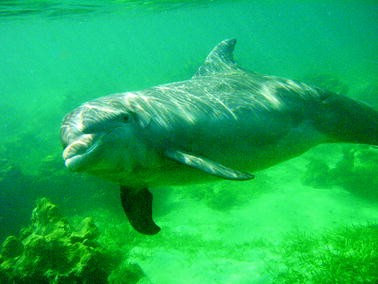
Research Reveals Dolphins Employ ‘Grins’ as a Sign of Playfulness

### Do Dolphins Exhibit Smiles? New Research Uncovers How These Intriguing Marine Mammals Convey Playfulness
Have you ever come across an image of a dolphin appearing to smile at the camera? It’s one of the many reasons people adore dolphins, as their delightful “smiles” give off an impression of warmth and happiness. However, this expression seems to serve a significant role in their social exchanges rather than being a mere eccentricity.
A recent study published in *iScience* has illuminated this behavior, indicating that bottlenose dolphins often display open-mouth expressions throughout playful interactions. Even more fascinating is their habit of imitating this gesture when another dolphin shows it first. Researchers propose that this action, known as **rapid facial mimicry**, serves as a nonverbal signal of playfulness and aids in sustaining amicable social exchanges.
### Methodology of the Study
Collaborative researchers from Italy and France meticulously observed 22 bottlenose dolphins at two sites: Zoomarine in Rome, Italy, and Planète Sauvage in western France. By examining the dolphins during various situations—engaging in play with one another, interacting with humans, or being solitary—the scientists identified a clear pattern: dolphins were much more inclined to exhibit open-mouth expressions during interactions with peers, especially while playing.
The results revealed that an astounding **92% of these “smiles” appeared when dolphins were engaging in play with each other**, rather than in solitude or during sessions with human trainers. This finding robustly supports the notion that the open-mouth expression is closely related to playful conduct among dolphins. Researchers noted that when one dolphin “smiled” at another during a playful exchange, the other dolphin mirrored this behavior approximately one-third of the time. Such mimicry is likely to enhance the playful essence of their interaction and signify mutual intentions, preventing any misinterpretation that could lead to aggression.
### The Function of “Smiles” in Dolphin Communication
The researchers suggest that open-mouth expressions serve as a means for dolphins to express playful intentions, clarifying that their behaviors are not hostile. This is vital in social creatures like dolphins, as misunderstanding gestures could initiate conflict. Interestingly, this behavior was **not identified during aggressive interactions** or in neutral scenarios, such as relaxed swimming.
Using “smiles” as a sign of playfulness is not a behavior unique to dolphins. Similar patterns have been documented in other mammals, including humans, primates, and horses. For instance, when young chimpanzees or human children engage in play, you often observe open-mouth smiling or laughter, which conveys non-threatening intent. Researchers speculate that this gesture evolved from the motion of biting, altered and intensified to express friendliness in a secure setting.
### And What About Vocal Communication?
While dolphins are already recognized for their sophisticated vocal communication—including whistles and clicks utilized for intricate social interactions—this recent study underscores the significance of *visual* communication in their playful actions. Nonetheless, the researchers did not explore the role of sounds during playful interactions, leaving this an area for further inquiries.
Livio Favaro, a zoologist from the University of Turin and one of the study authors, pointed out an interesting aspect: dolphins strategically manage their vocalizations. “Dolphins have developed one of the most elaborate vocal systems in the animal kingdom, but sound can also put them at risk from predators or eavesdroppers,” Favaro stated. Therefore, a blend of visual signals (such as the open-mouth expression) and vocal sounds likely aids them in coordinating more subtly during playful activities.
### The Importance of Playfulness for Dolphins
Playfulness is a vital aspect of dolphins’ social lives, irrespective of their age. It fosters social connections, expresses emotions, and differentiates between friendly and aggressive behaviors. Bottlenose dolphins, often referred to as the “primates of the ocean,” are celebrated for their exceptional intelligence and social intricacy. With a brain-to-body-mass ratio surpassed only by humans, they demonstrate behaviors like self-recognition in mirrors, forming social partnerships, and even teaching hunting strategies to their young.
This research adds a new dimension to our comprehension of their impressive social structures. While the connection between physical gestures like the open-mouth expression and playfulness is now apparent, the potential for vocal elements accompanying these behaviors could provide deeper insights into how dolphins communicate and cooperate.
### What Distinguishes This Research?
This study is pioneering as it signifies the **first investigation of visual communication of this nature in marine mammals.** While we are already acquainted with dolphins’ vocalizations, analyzing their nonverbal communication, such as open-mouth “smiling,” paves new paths for understanding the social dynamics of these marine creatures.
Previous research has identified comparable behaviors in species such as humans and primates. For instance, young chimpanzees frequently replicate open-mouth grins during play, while human infants exhibit “social smiles” to form connections with caregivers and peers. Horses, too, are recognized for conveying non-aggressive communication during play with open mouths. This cross-species consistency